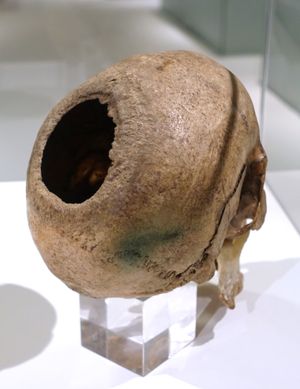Author: Aubrey Minshew, Museum Specialist, Truhlsen - Marmor Museum of the Eye®
Modern surgery is a very advanced and technologically innovative undertaking. For instance, a modern cataract surgery can be performed on a 3D microscope, is virtually painless, and can remove the eye’s natural lens and replace it with a plastic implant — all in under half an hour. With all this cutting-edge technology, it’s easy to imagine that surgery is a wholly modern enterprise. The real story, however, starts thousands of years ago, even before the written word, and eye surgery specifically is among these early surgical procedures.
Trepanning, also called trephination, is the oldest known surgical procedure. Trepanning is a very basic cranial surgery in which a sharp-edged tool is used to bore a hole in the skull. Trepanned skulls start showing up on the archaeological record during the Neolithic Age (c. 4300–2000 BCE). Surprisingly, they are not unique to just one culture. They can be found in numerous ancient burial grounds throughout Europe, Asia, and North and South America. There are many different hypotheses for trepanning’s intent, ranging from religious practice to relieving cranial pressure, to perhaps behavioral modification. While the intent might never be known for certain, what is known is that many of these skulls show signs of healing after the operation (some sources say up to 40 percent!). That’s an astonishing number, considering the lack of pain management or antiseptics.

A Neolithic trepanned skull at a museum in Braunschweig, Germany
If you want to trace the roots of surgeries on soft tissues that decompose easily (such as the eye), you have to wait until people began to write their findings down. Let’s take a look at three notable ancient documents that show us evidence of early surgical procedures: the Code of Hammurabi, the Ebers Papyrus, and Sushruta Samhita.
The Code of Hammurabi (c. 1755 BCE–1750 BCE) is an ancient Babylonian legal text written in what is now Iraq. The Code is predominantly concerned with eye-for-an-eye—style justice, codifying injuries and harms and meting out appropriate payments and punishments. It is speculated that the Code might contain the oldest-known reference to eye surgery — the surgery itself is not named or described, but the Code does dictate that a doctor who causes a patient to lose an eye in surgery must have their hands cut off.

Cuneiform text from the Code of Hammurabi, c. 1755 BCE
Descriptions of ancient surgery become more detailed in an Egyptian text called the Ebers Papyrus (c. 1550 BCE). The Ebers Papyrus does describe many eye maladies, such as bacterial infections and cataracts, but it doesn’t describe any eye surgeries specifically. It’s considered an extremely valuable source in surgical history because it portrays other fairly complicated procedures, such as surgically immobilizing broken bones with resin orthopedic screws and sewing up surgical incisions with sutures made of linen thread.

A modern Egyptian postage stamp depicting the Ebers Papyrus, 1971
Almost one thousand years after the Ebers Papyrus, a doctor in India named Sushruta wrote a Sanskrit manuscript called Sushruta Samhita (c. 600 BCE). Among the many medical concepts Sushruta discusses, we can see two easily recognizable modern surgeries: couching of cataracts and, surprisingly, rhinoplasty. Removal of the nose or ears was a common criminal punishment, and Sushruta discusses how to create a new nose by inserting two small pipes as nostrils and suturing a small flap of skin from the cheek over them (as he writes, “in the shape of a leaf.”) Couching, the earliest form of cataract surgery, is described as using a long sharp needle or spine to dislodge the cloudy lens and push it towards the bottom or back of the eye. Couching in some form was essentially the standard of care for cataracts until well into the modern era, when Jacques Daviel performed the first extracapsular cataract extraction in 1750.

An ancient couching needle from the museum collection, c. 500 BCE
So, while modern surgeries have grown leaps and bounds, they can all trace their roots back to Neolithic humans boring holes in the skull and ancient Indian doctors trying to restore sight with long, sharp needles. People have been attempting to perform surgeries almost as long as we have been farming and living together in communities, which places the modern marvel of surgery into a long and fascinating historical contex.
Want to learn more about the texts mentioned here? Check out our online exhibit, “History of Ophthalmology in the Asia Pacific,” or explore the trajectory of cataract surgery in “Cataracts: Couching to Phaco.”